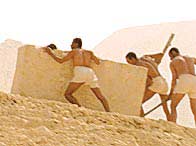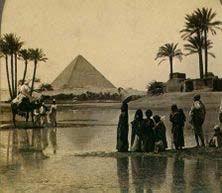Workers' lives build pyramids
 For decades, the Egyptian pyramid revealed to the people many details of the pharaoh's life in ancient Egyptian society. However, for a long time, not many people talked about the lives of those who brought their sweat, tears and blood to create these great buildings.
For decades, the Egyptian pyramid revealed to the people many details of the pharaoh's life in ancient Egyptian society. However, for a long time, not many people talked about the lives of those who brought their sweat, tears and blood to create these great buildings.
It is the workers from all over Egypt who participate in construction sites, which, recently, through the archaeological findings analyzed by modern technology, are less known. much about their lives.
For a long time, when it comes to Egyptian pyramids, in addition to the uncrypted mysteries of pharaohs, researchers are often obsessed with questions regarding those who directly create them. : What social component are they? Where do they live before and during the construction of the pyramid? What is the daily life of a construction worker and their family?
The first hypotheses to answer some of these questions were given in 1888, through the archaeological investigation of the English scientist Flinders Petrie at Senwosert II 's pyramid complex in Ilahun. Here, a walled area reveals a picture of a town with high-rise buildings, mud-brick walls, inside with papyrus manuscripts, pottery, tools and clothes. and children's toys,
 and all the fragments of everyday life that were not available at any previous archaeological excavation sites. The first Egyptologists in archaeological history did not take the time to survey and explore the ancient Egyptian civilian architectures. Until recently, thanks to the extensive excavations by Egyptologists Mark Lehner and Zahi Hawass around the Great Pyramid area ( Great Pyramid ), people learned more about the lives of construction workers. Pyramid here.
and all the fragments of everyday life that were not available at any previous archaeological excavation sites. The first Egyptologists in archaeological history did not take the time to survey and explore the ancient Egyptian civilian architectures. Until recently, thanks to the extensive excavations by Egyptologists Mark Lehner and Zahi Hawass around the Great Pyramid area ( Great Pyramid ), people learned more about the lives of construction workers. Pyramid here.
According to the Greek historian Herodutus, the Great Pyramid was built by 100,000 continuous slaves and was replaced once every three months with new groups of workers. However, according to current researchers, this is a mistake of Herodutus. King Khufu, the ruler of Egypt in the fourth dynasty - the dynasty responsible for carrying out the Great Pyramid - could not have such a powerful work force in his hands. Besides, if that were the case, it would not be possible for 100,000 people to build a pyramid at the same time. Each archaeologist has his own calculation of the number of workers involved in this work, but most agree that the Great Pyramid was made by nearly 4,000 highly skilled workers, such as stone miners, transport workers, masons, with the help of about 16,000 - 20,000 assistant workers, in charge of making slopes, mixing mortar, supplying food, clothes, fuel . So, count the total number of people participating in the construction of the Great Pyramid is about 20,000 - 25,000 people, working for 20 years or longer.
Researchers estimate the number of workers is divided into two forces, a permanent workforce with a salary of about 5,000 people, living with their wives and children and other relatives in a well-organized village. And a temporary workforce of 20,000 people, working every three or four months, lives in less regulated camps along the pyramid village. Today, it is found a huge limestone wall separating the area of the living with the "Jiangshan" of the dead. The main village of pyramid builders is located outside this wall, close to the temple of the pyramid. Unfortunately, most of this village is located below the modern town of Nazlet-es-Samman, so access is difficult.

Today, archaeologists discover a gentle cemetery, where men, women and children of the pyramid village are buried. Their graves are very diverse, there is a small pyramid, with a pyramid-shaped pyramid, with a domed tomb, often made of expensive stones "borrowed" from metal construction materials. main tower. Larger limestone tombs located at the top of the cemetery slope are the burial sites of those responsible for managing construction operations and material suppliers. In the past, pyramid robbers did not pay attention to these types of cemeteries so far many remains remain intact, allowing scientists to recreate the lives of those who have lived, worked and died at Giza.
Of the 600 sets of remains surveyed in the pyramid cemetery, it was found that nearly 50% were women, the number of children and babies also accounted for 23% of the total, which easily allowed the conclusion. It was during construction of the pyramid that the main workers lived with their wives and children right under the shade of the giant tomb for the pharaohs.
In the graves of the project supervisors contain inscriptions describing the organization and inspection of the workforce. But this text provides us with an understanding of the pyramid construction system. They show that temporary use of labor is a typical Egyptian solution to logistics. In the Giza pyramid, the workforce is divided into groups of 2,000 people and continues to divide into small groups of 1,000 people, 200 people and stops at a group of 20 people.
The temporary workers of the pyramid construction site live in temporary camps next to the town. Here, they receive wages in the form of food rations. The standard under the ancient kingdom (2686-2181 BC) for a worker was 10 loaves of bread and a pint of beer every day.
 Construction supervisors and higher status recipients receive hundreds of loaves of bread and many beers a day. These are foods that cannot be stored for a long time, according to researchers, they will be marketed, exchanged for other products or money. In any case, a pyramid town, like every other Egyptian town, will soon develop its own economy.
Construction supervisors and higher status recipients receive hundreds of loaves of bread and many beers a day. These are foods that cannot be stored for a long time, according to researchers, they will be marketed, exchanged for other products or money. In any case, a pyramid town, like every other Egyptian town, will soon develop its own economy.
Temporary workers at the labor site will be buried with the equipment they have purchased. In the survey, archaeologists found that their graves were hastily buried and poor in appearance compared to those of permanent workers. In the south of the pyramid town, it was discovered that an industrial zone was divided into blocks or corridors separated by paved roads installed with sewers and houses of several workers. Mark Lehner discovered a copper factory, two bakeries with enough molds to bake hundreds of loaves of bread at the same time and a fish-making device with the leftovers of thousands of fish. This is a large amount of food for many people, although today, Lehner has not found a trace of a store or food store. The bones of animals found in the pyramid town and the nearby areas came from ducks, sheep, and pigs . They could be kept in the house, in the pyramid town's workshop, but Other high-grade cattle such as cows can be kept on wide pastures and transported to town.
After comparing DNA samples from remains of pyramid construction workers with samples from contemporary Egyptian residents, Dr. Mopamia of Cairo University Medical School hypothesizes that the pyramid Kufu is a national-scale project, with workers coming from all over Egypt. Of course, this female scientist did not find any trace of strangers, even interplanetary people as the word of many people. In fact, the pyramid is both a giant training project and a "Egyptian" source. Workers leave communities with only 50 or 100 people, to live and work in a town of up to 15,000 or more people. They returned to their homeland with new skills, a broader perspective and a new sense of nation. Paying them, even in the form of diets, is a national form of income re-distribution.
It can be said that in ancient Egypt, most families were directly or indirectly involved in the construction of pyramids. However, unlike Herodotus' hypothesis for oppressive slaves, Lehner and Hawass suggest that they could be volunteers. Hawass said the pyramid symbol has enough spiritual strength to volunteer for the national interest. Mark Lehner went even further, comparing pyramid construction with the establishment of Amish sect in America, based on a voluntary spirit. Is it a new discovery related to the labor regime of the participants to build great works of Egypt in particular and all humanity in general?
- Theories about how to build pyramids in ancient Egypt
- Maybe the ancient Egyptians used this method to build pyramids
- How to transport stone to build pyramids of ancient Egypt
- Unique pyramids are not located in Egypt
- The cosmic particle may be the way to find out how the pyramid was built
- Find out how the Egyptians moved giant stones to 800km to build pyramids
- New discovery of ancient Egyptian tools using the construction of the Giza Pyramid
- Construction errors caused the Great Egyptian pyramid to deviate
- Is the Egyptian pyramid built up from the inside out?
- Unexpected discovery of the pyramids at Giza
- Europe prepares laws for robot workers revolution
- The truth after the Giza Pyramid Project
 Discovered an ancient centipede fossil 99 million years old
Discovered an ancient centipede fossil 99 million years old Discovered bat-like dinosaurs in China
Discovered bat-like dinosaurs in China Discovered a 200-year-old bronze cannon of the coast
Discovered a 200-year-old bronze cannon of the coast Discover 305 million-year-old spider fossils
Discover 305 million-year-old spider fossils